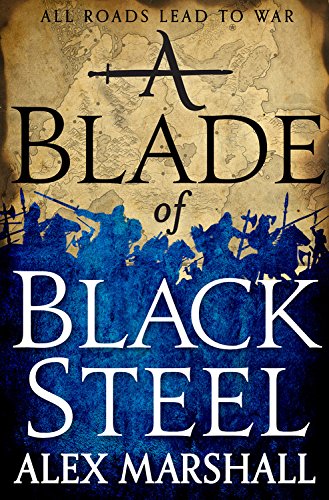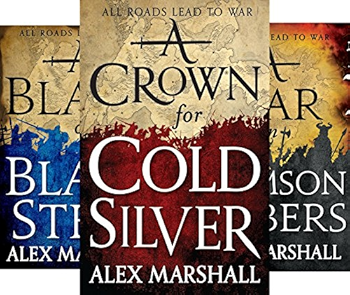
![]() A Blade of Black Steel by Alex Marshall
A Blade of Black Steel by Alex Marshall
Alex Marshall‘s A Blade of Black Steel (2016), the sequel to A Crown for Cold Silver, continues turning the sword-and-sorcery genre on its head while displaying Marshall’s obvious love of both swords and sorcery. Character development is the key this time around, much to the enrichment of the novel itself and the series as a whole. But don’t get too complacent — the entire world may be coming to an end, after all.
Warning: there will be some mild spoilers for A Crown for Cold Silver.
Following the disastrous events at the end of A Crown for Cold Silver, Cobalt Zosia and four of her Five Villains are left to lick their wounds. The remaining members of the Cobalt Company under the princess-turned-general Ji-hyeon are still a sizable force, but morale is low, and news that more of the Crimson Empire’s forces are rapidly approaching doesn’t help. Maroto has been kidnapped and left on a mysterious previously-sunken island which shouldn’t exist, where he runs into foul monsters and armored foes, but is saved by pirates led by Captain Bang. Maroto wants to get back to the Star and rejoin his fellows; however, Ji-hyeon and Maroto’s nephew Sullen think he’s deserted them, and Sullen takes a small band of people along his quest to end his cowardice once and for all.
Meanwhile, the mad followers of the Burnished Chain church have overtaken the city of Diadem and cast Queen Indsorith into the torture dungeons. The reappearance of the Sunken Kingdom might be causing devastating climatological change in addition to the religious and political upheaval across the entire continent. Ji-hyeon starts to wonder how much agency she’s truly had or whether she’s just been a figurehead for the rebellion — and how to separate her goals from her advisers’ — and Zosia must reckon with the still-continuing echoes of her actions as a rebel leader, a queen, and an outcast. And that’s not even a fifth of what’s at stake in A Blade of Black Steel.
Marshall wisely uses this novel as an opportunity to let the characters take a breath, sharpen their weapons, and repair their armor; it’s unrealistic to think that people who have recently lost limbs or experienced severe trauma would be capable of immediately marching off to another battle. Instead, readers are given insight into character motivations and histories which enrich our understanding of why these people fight, why they’ve abandoned family members or other obligations to follow a blue-haired woman who isn’t actually a figure out of legend. This authorial choice has the potential to be dreadfully dull, but Marshall continues the great character work established in the previous novel and fleshes out previously-secondary characters like Tapai Purna, Digglesby, and even Baron Domingo beyond my expectations. The end result is a further enrichment of an already-impressive cast, and subsequently, it’s impossible to make a clear judgement as to whether anyone in A Blade of Black Steel is simply a hero or a villain.
I enjoyed getting to know these characters better and genuinely appreciated Marshall’s adept explorations of human nature. The conversations and internal dialogue that the reader is privy to are essential, without question: it’s imperative to see the shift in General Ji-hyeon’s thinking as she begins to consider whether it’s a good idea to get sucked into the seemingly endless cycle of forming an army to overthrow the current ruler, only to later be marked as a tyrant and sow the seeds of insurrection against herself (as with Cobalt Zosia and then Queen Indsorith before her). We need to see all of the pieces moving into place as the new Cobalt Company prepares to march on the city of Diadem. And we need the conflicting and contradictory viewpoints from, say, Maroto and Sullen, who have wildly different interpretations of reality and their own actions, because those kinds of misunderstandings and miscommunications are at the heart of everything that’s happened since long before page 1 of A Crown for Cold Silver. Those conversations and character insights are so valuable that a battle against a giant she-devil midway through the book interrupts the flow of intrigue and back-stabbery just as it was getting really, really good.
So what are my complaints? For one, the pacing in A Blade of Black Steel is a little uneven, as mentioned above. It’s also hard to get a sense for how much time is passing for disparate groups of characters, some of whom are traveling long distances on foot and some of whom are, largely, staying put at camp. The chapters are structured in such a way that weeks could pass for some people, while only days pass for others, but it’s all presented as one linear flow. A little more explanation or even some restructuring would have gone a long way.
Secondly, it would have been great to get some perspectives from the side of the Burnished Chain, especially since A Blade of Black Steel opens with Pope Y’Homa successfully overthrowing Queen Indsorith. What are the Burnished Chain’s motivations for their actions at the end of A Crown for Cold Silver, and what do they think their actions during A Blade of Black Steel will accomplish? Tidbits of horrifying information are dropped here and there by characters that rail against this mad church, but the viewpoint provided by Sister Portolés in the first book was noticeably lacking this time around. My hope is that a broader, more nuanced range of sides will be provided in the next book, A War in Crimson Embers.
Happily, Marshall’s all-inclusive approach to races, gender roles, and self-identification is as strong here as it was in the first book. Preferred pronouns are used respectfully and casually, with no expressed frustration or judgement, and it’s fascinating to see how various cultures make allowances for the dilemma of feeling dissociated from the body a person is born into. It’s such a non-issue for the societies of the Star, in fact, that there were a few times when I discovered that I’d been making incorrect assumptions of my own, and had to rethink my approach to certain characters.
Stylistic quibbles aside, A Blade of Black Steel was a worthwhile read, and the added depth of character is invaluable. I do have to admit, though, I legitimately have no idea what to expect in the final installment of the CRIMSON EMPIRE trilogy, A War in Crimson Embers, and I’m a little afraid of what horrors await me and the characters I’ve grown to love. Recommended.



Enjoyed your review. I’m reading A War in Crimson Embers and am having the hardest time reminding myself where everybody is at the start of the novel. I love the absolute as you put it ‘all-inclusiveness’ of this world. Were that ours was more reflective of that ideal. Now to find a review of Crimson Embers that recaps Black Steel.